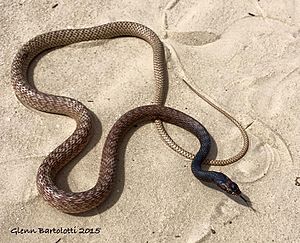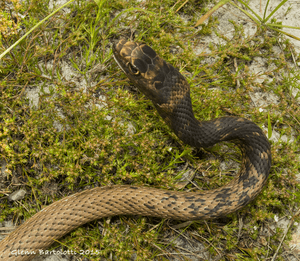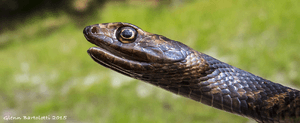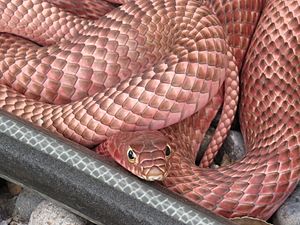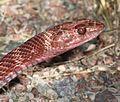Masticophis flagellum facts for kids
Quick facts for kids Masticophis flagellum |
|
|---|---|
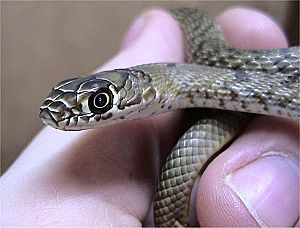 |
|
| Juvenile western coachwhip Masticophis flagellum testaceus |
|
| Conservation status | |
| Scientific classification | |
| Genus: |
Masticophis
|
| Species: |
flagellum
|
| Synonyms | |
|
|
The Masticophis flagellum is a type of non-venomous snake. It is commonly known as the coachwhip or whip snake. These snakes are found only in the United States and Mexico. There are six different types, or subspecies, of coachwhips.
Contents
Where Coachwhips Live
Coachwhips live across the southern part of the United States, from the Atlantic to the Pacific coasts. They are also found in the northern half of Mexico.
What Coachwhips Look Like
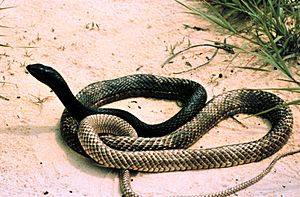
Coachwhips are slender snakes with small heads and large eyes. Their pupils are round. Their colors can be very different, but they usually match their surroundings. This helps them blend in with their habitat.
For example, the western coachwhip (M. f. testaceus) is often light brown with darker brown spots. But in western Texas, where the soil is pink, the coachwhips there are also pink! The red coachwhip (M. f. piceus) often has some red color, but not always.
The scales on a coachwhip are arranged in a way that makes the snake look like it's braided. It can be hard to tell the different types of coachwhips apart where their living areas overlap.
Adult coachwhips are usually about 127 to 183 centimeters (50 to 72 inches) long. The longest eastern coachwhip ever found was 259 cm (102 in) long! Young coachwhips, just over 100 cm (39 in) long, weigh about 180 to 675 grams (6.3 to 23.8 ounces). Larger adult coachwhips, measuring 163 to 235 cm (64 to 93 in), can weigh 1.2 to 1.8 kilograms (2.6 to 4.0 pounds).
Coachwhip Homes
Coachwhips prefer open areas with sandy soil. You can often find them in open pine forests, old fields, and prairies. They especially like sandhill scrub areas and coastal dunes.
Coachwhip Behavior
Coachwhips are active during the day. They hunt and eat lizards, small birds, and rodents. When they catch prey, they hold it firmly with their jaws. They do not squeeze their prey like some other snakes.
These snakes are very aware of their surroundings. If they sense danger, they often quickly run away. But if they feel trapped, they will strike. Their bites can hurt, but they are usually not dangerous unless they get infected, just like any other small wound.
Coachwhips are curious and have good eyesight. Sometimes, you might see them lifting their heads above the grass or rocks to get a better look around. They are also extremely fast, able to move up to 6.4 kilometers per hour (4 miles per hour)!
Types of Coachwhips
There are six recognized types of Masticophis flagellum:
- Masticophis flagellum cingulum – Sonoran coachwhip
- Masticophis flagellum flagellum – eastern coachwhip
- Masticophis flagellum lineatulus – lined coachwhip
- Masticophis flagellum piceus – red coachwhip, also called red racer
- Masticophis flagellum ruddocki – San Joaquin coachwhip
- Masticophis flagellum testaceus – western coachwhip
When you see a name like (Cope, 1892) in parentheses after a subspecies name, it means that type of snake was first described under a different genus name than Masticophis.
Myths About Coachwhips
There are many old stories and myths about coachwhip snakes. One common myth is that they chase people. This probably happens because both the snake and the person are scared and try to escape in the same direction. Since coachwhips are very fast, they might seem like they are chasing you if they move towards you.
Some legends, like the hoop snake myth, might be about coachwhips.
Another myth from the southeastern United States says that if a coachwhip is disturbed, it will chase a person, wrap around them, and whip them to death with its tail. Then, it supposedly checks if the person is still breathing by sticking its tail up their nose. This is not true! Coachwhips do not squeeze their prey (they are not constrictors), and they are not strong enough to hurt a person in this way. Also, they do not whip with their tails, even though their tails look like whips.
In parts of Mexico, ranchers have stories about chirrioneras (coachwhips). They believe these snakes can hypnotize women and drink their breast milk. The story says that if a woman has a crying baby, the snake will put its tail in the baby's mouth to keep it quiet while the snake feeds. This would leave the baby hungry and weak. The only sign, according to the myth, would be sores around the baby's mouth. These stories are also not true. Snakes do not drink milk from mammals.
In 1888, a farmer near Orlando, Florida, claimed he saw a 16-foot coachwhip with a head four inches wide. He said after the snake swallowed a rabbit, he tried to shoot it. Then, the snake supposedly raised its head as high as a person and "began racing back and forth towards him." While coachwhips are fast, this story is likely exaggerated.
Images for kids
-
Head of an eastern coachwhip (Masticophis flagellum flagellum) from the Ozarks, Missouri (3 March 2021)
See also
 In Spanish: Chirrionera para niños
In Spanish: Chirrionera para niños



